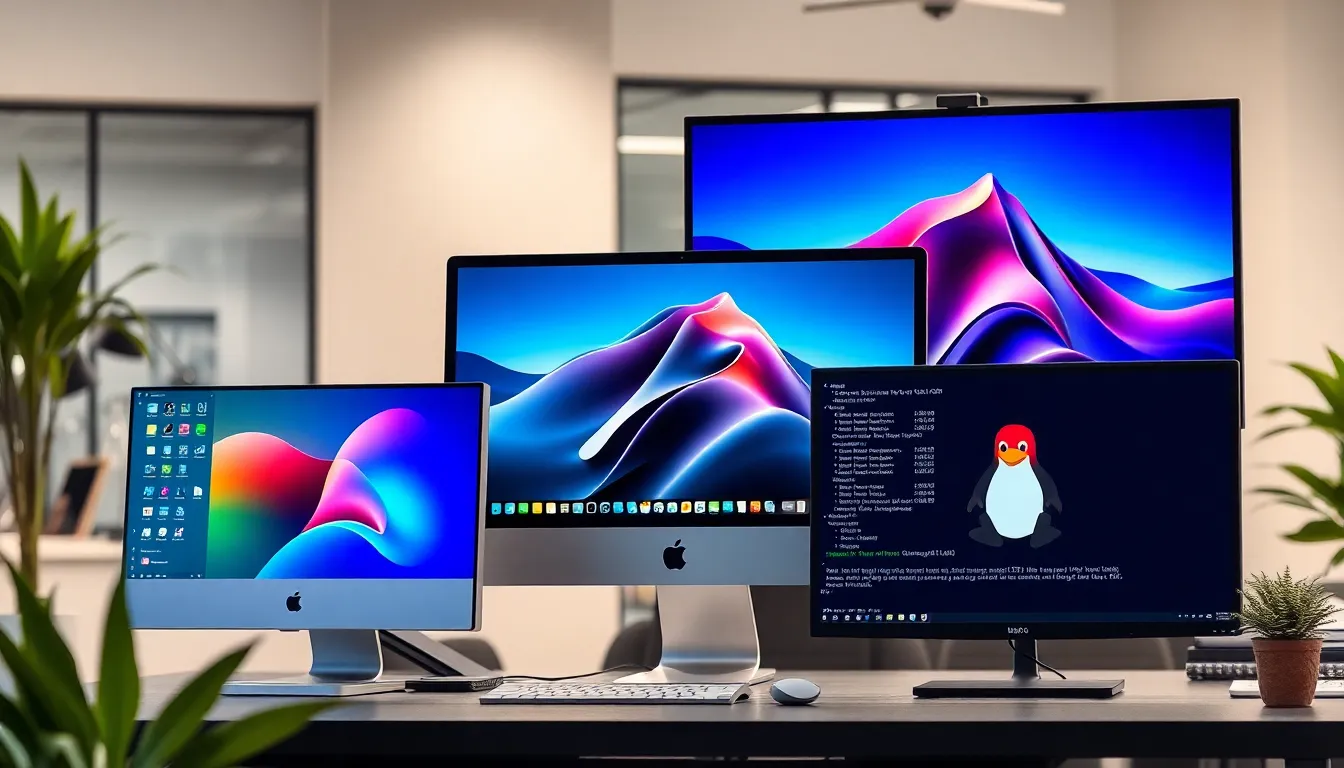In the bustling world of technology, operating system software is the unsung hero that keeps everything running smoothly. Think of it as the conductor of a grand orchestra, ensuring that all components harmonize perfectly. Without it, your computer would be as useful as a chocolate teapot—great to look at but utterly useless when it comes to performing tasks.
Table of Contents
ToggleOverview Of Operating System Software
Operating system software serves as a crucial interface between users and hardware. Systems like Windows, macOS, and Linux manage resources, enabling tasks such as memory management and process scheduling. Functions of these operating systems guarantee that applications run smoothly and efficiently.
Users interact with file systems, network protocols, and graphical user interfaces. Operating systems provide essential services like error handling and security measures to protect user data. They also enable the execution of applications by managing system calls, ensuring tasks are completed without conflicts.
Different types of operating systems cater to varying needs. Real-time operating systems suit embedded systems in medical devices and automotive applications. Server operating systems optimize performance for web hosting and databases, with examples like Ubuntu Server and Windows Server.
Open-source operating systems foster community collaboration and customization. Users can modify the source code, encouraging innovation and adaptability. Proprietary systems like macOS deliver a controlled environment but limit customization options.
Keeping software updated remains crucial. Regular updates enhance security, fix bugs, and improve performance. Users benefit from staying informed about compatibility with new hardware and software releases.
Understanding the role of operating system software is essential in today’s digital world. It lays the foundation for software applications and hardware performance. An effective operating system enhances user experience, streamlines workflows, and drives technological advancement.
Types Of Operating System Software

Operating systems exist in various forms, tailored for specific user needs and environments. Understanding these types provides insight into their roles and functionalities.
Desktop Operating Systems
Desktop operating systems serve personal computers and workstations. Microsoft Windows dominates this category, offering user-friendly interfaces and extensive software compatibility. macOS caters to Apple users, emphasizing design and ease of use. Linux, an open-source option, attracts users seeking customization and flexibility. These systems facilitate multitasking, support peripheral devices, and manage hardware resources efficiently. Each platform provides unique features that accommodate different user preferences and workflows.
Mobile Operating Systems
Mobile operating systems power smartphones and tablets. Android leads the market with its open-source nature and widespread device compatibility. iOS, exclusive to Apple devices, boasts a secure environment and seamless integration with hardware. These mobile OS frameworks optimize performance while maintaining battery efficiency. They support a diverse range of applications, enabling users to access multimedia, productivity, and communication tools. The adaptability of these operating systems enhances the mobile user experience, catering to individual preferences.
Server Operating Systems
Server operating systems manage network resources and support client requests. Popular options include Windows Server, known for its robust management capabilities, and Linux-based systems like Ubuntu Server, prized for stability and security. These OS versions handle high traffic loads and offer security measures to protect sensitive data. Virtualization technologies often integrate with server operating systems, maximizing hardware resources. Efficient performance and reliability make these operating systems essential for web hosting and enterprise environments.
Key Functions Of Operating System Software
Operating system software performs several essential functions that ensure efficient computer operation. These functions include resource management, user interface, and security features.
Resource Management
Resource management involves efficiently allocating hardware resources like CPU, memory, and storage. The operating system prioritizes processes, determining which tasks receive the most resources at any given time. One example is memory management, where the OS tracks memory usage and reallocates it between applications for optimal performance. Additionally, process scheduling allows multiple tasks to run smoothly without interference. By managing I/O devices, the OS ensures that data flows seamlessly between hardware and applications, thereby enhancing overall system efficiency.
User Interface
User interfaces create the environment through which users interact with the operating system. Graphical user interfaces (GUIs) provide intuitive icons, buttons, and menus for easy navigation. Conversely, command-line interfaces (CLIs) offer a text-based platform for users who prefer commands over graphical elements. Operating systems like Windows and macOS focus on user-friendly interfaces, making them accessible to diverse user levels. Touch interfaces in mobile operating systems emphasize direct engagement, catering especially to touch-screen devices. This versatility in user interfaces promotes better accessibility and improved user experiences.
Security Features
Security features within operating system software protect against unauthorized access and data breaches. Operating systems implement user authentication systems such as passwords or biometrics to verify users. Firewalls and antivirus programs form additional layers of protection, monitoring incoming and outgoing traffic for threats. Regular software updates address vulnerabilities, ensuring that systems remain secure against emerging threats. Moreover, file permissions regulate access to sensitive data, providing peace of mind for users. By integrating these security measures, operating systems maintain user trust and safeguard vital information.
Popular Operating System Software
Operating system software serves as the backbone of computing devices. This section explores some of the most widely used operating systems: Windows, macOS, and Linux.
Windows
Windows, developed by Microsoft, dominates the desktop operating system market. Its versatile ecosystem supports a wide range of software applications, making it popular among business and home users. User-friendly interfaces contribute to Windows’ appeal, while features like the Start menu and taskbar simplify navigation. Security updates released regularly protect users from vulnerabilities. Additionally, compatibility with various hardware enhances its accessibility across devices. A vast community of developers contributes to continuous improvements, ensuring that Windows remains relevant in an evolving landscape.
macOS
macOS, Apple’s operating system, provides a seamless experience for users of Mac computers. Its integration with Apple hardware optimizes performance, delivering an efficient user experience. A visually appealing interface attracts creative professionals, particularly in graphic design and video editing. Built upon a UNIX foundation, macOS offers robust security features, ensuring data protection for users. Regular updates enhance functionality and introduce new features, keeping users engaged. The ecosystem’s compatibility with devices like iPhones and iPads encourages a cohesive digital experience.
Linux
Linux stands out as a popular open-source operating system known for its flexibility and customizability. Various distributions cater to different user needs, including Ubuntu for beginners and CentOS for enterprise environments. Linux appeals to developers and system administrators due to its powerful command-line interface and extensive software repositories. Frequent updates ensure system security and stability, while community support fosters innovation. Additionally, the cost-free nature of Linux presents an attractive option for organizations looking to minimize expenses. Its adaptability enables deployment across servers, cloud platforms, and personal computers alike.
Future Trends In Operating System Software
Emerging technologies will shape the future of operating system software significantly. Artificial intelligence integration offers new functionalities, enabling systems to adapt to user behaviors seamlessly. Cloud-based operating systems are gaining traction, promoting accessibility and collaboration across devices. Enhanced security measures, driven by the increase in cyber threats, become essential, with advanced encryption and real-time monitoring features.
Virtual and augmented reality support are expected to revolutionize user interactions, providing immersive experiences in various applications. Edge computing is also on the rise, allowing processing closer to the data source, minimizing latency. Open-source operating systems may see more widespread adoption, as communities collaborate to innovate and improve features continuously.
In addition to these advancements, the demand for lightweight operating systems continues to increase, supporting Internet of Things devices which require less resource consumption. Adaptability is crucial, and operating systems must evolve to meet diverse user needs, from mobile platforms to complex server environments.
User interfaces will likely evolve as touch and gesture-based interactions grow more common. Simplified access to settings and controls may enhance user experience significantly. Mobile-first approaches drive the design of operating systems, prioritizing performance and efficiency on smartphones and tablets.
Furthermore, automation in operating systems will streamline tasks, enhancing productivity for users across different sectors. Continuous updates will remain vital to address vulnerabilities promptly while improving functionality. Emphasis on energy-efficient operating systems is also expected as sustainability becomes a priority for both consumers and manufacturers.
Operating system software stands as a fundamental pillar in modern computing. It not only ensures that hardware and software work in harmony but also shapes user experiences across various devices. As technology evolves, the role of operating systems will continue to expand with innovations like artificial intelligence and cloud computing.
The future promises exciting developments such as enhanced security measures and energy-efficient designs. Staying informed about these advancements will empower users to make better choices in their technology use. Ultimately, understanding operating systems is essential for navigating the digital landscape effectively and securely.









